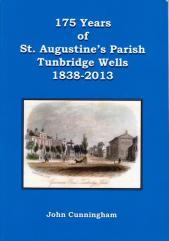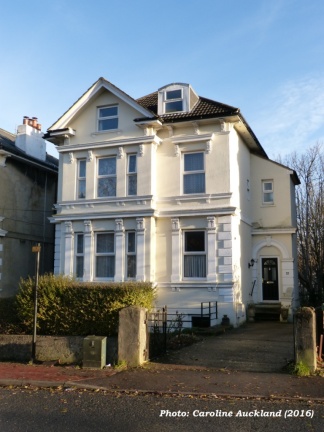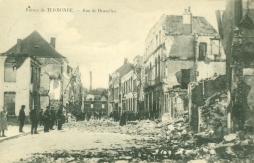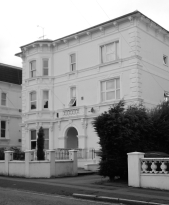This house was lent to the Belgian Refugees’ Committee in October 1914 by Canon KEATINGE of St Augustine’s Roman Catholic Church, and I have been wondering what the connection might be.
After my talk last month, the answer was given to me by a member of the audience : it had been owned by Mrs Mary Hannah FENWICK, a generous benefactor, who left it to the parish in her will.
To find out more, I turned first to John Cunningham’s 2013 monograph 175 Years of St. Augustine’s Parish Tunbridge Wells 1838-2013.

There I learnt that Mrs FENWICK, her husband and son (born 1864, and suffering from some sort of disability) were originally from Yorkshire, had lived first in Tonbridge, and then, from about 1887, at Cintra House.
She and her son converted to Catholicism, and in 1899, after the deaths of both her son and her husband, Mrs FENWICK made generous donations to St Augustine’s Church, and to the Roman Catholic community in Tonbridge for the establishment of Corpus Christi Church, in return for which she would receive an annuity and also have Masses said for her and her family in perpetuity.
“Her offer was quickly accepted” writes John Cunningham, “since no one thought for one moment that she would live for another 16 years. Her unexpected longevity would largely wipe out any benefit from her offer……In all, Mrs Fenwick gave £8,500 and received back about £7,450 in annuities, as well as at least 2,475 Masses for the repose of her soul and those of her family.”
A mixed blessing indeed!
The parish sold Cintra House in 1918 for £763-8s-0d.

Further research in the British Newspaper Archive and on Ancestry fleshed out the picture a little more.
Mrs Fenwick was born Mary Hannah HALLEWELL the oldest of 8 children (6 girls, 2 boys) born to Wine Merchant Benjamin HALLEWELL and his wife Hannah of Leeds, Yorkshire, non-Conformists. She was 38 when she married Yorkshire farmer William FENWICK, 7 years her junior, in 1862. Their son Walter was born in Kirkby Moorside 2 years later.
In 1871 the family was still in Yorkshire, but by 1881 they had moved to Dry Hill Park, Tonbridge, to a house called Heather Bank. Walter died at the age of 22 in early 1886, and it was perhaps after that that his parents moved from Tonbridge to Tunbridge Wells. In 1887 they paid for a classroom to be made in the crypt of St Augustine’s Church in his memory (Kent and Sussex Courier 15 July 1887).
William FENWICK died on 19 September 1890 and was buried in the FENWICK family grave at All Saints Church, Kirkby Moorside. His widow lived on at Cintra House for another 15 years or so, moving in around 1905 to Gensing Lodge Convent in St Leonards on Sea, a home for elderly Catholic ladies run by Augustinian Sisters from France (1).
There she lived until her death on 5 September 1915. Canon James KEATINGE, parish priest of St Augustine’s, was executor of her will.
However, that was in 1915. She must already have left Cintra House in the care of Canon KEATINGE when she moved to St Leonards, as it was in October 1914 that the Belgian refugee families moved in.
In the 1911 Census the house was the home of widow Charlotte Georgiana MORRIS from London, but in Kelly’s Directory for 1914, 32 Upper Grosvenor Road has no entry – presumably it was by then one of the many empty houses in Tunbridge Wells.
Among the Belgians who lived there was Prosper DEBERGH from Dendermonde, the subject of an earlier blog post, and also Miss Adele VAN OBBERGEN from Louvain who escaped a fine under the Lighting Order in early 1916, the Mayor reminding her when she appeared before the bench that she was “living in a house which was being kept up by people in the town” and asking her “and the other guests to see that the lights were properly shaded” (Kent & Sussex Courier, 14 January 1916 (2)).
So there it is, some of the story of Cintra House.
Thank you to Caroline Auckland for the photos of the house as it is today.
Notes
(1) I think I am right in saying that the building on Upper Maze Hill is now part of St Michael’s Hospice – please correct me if I’m wrong.
(2) Note : Date corrected from 14 February 1916 on 10/09/2021
.






